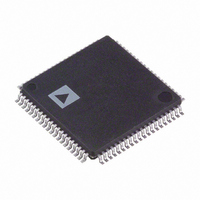AD9883AKSTZ-140 Analog Devices Inc, AD9883AKSTZ-140 Datasheet - Page 22

AD9883AKSTZ-140
Manufacturer Part Number
AD9883AKSTZ-140
Description
IC FLAT PANEL INTERFACE 80-LQFP
Manufacturer
Analog Devices Inc
Datasheet
1.AD9883AKSTZ-140.pdf
(28 pages)
Specifications of AD9883AKSTZ-140
Applications
Displays, Monitors, TV
Interface
Analog
Voltage - Supply
3 V ~ 3.6 V
Package / Case
80-LQFP
Mounting Type
Surface Mount
Lead Free Status / RoHS Status
Lead free / RoHS Compliant
Available stocks
Company
Part Number
Manufacturer
Quantity
Price
Company:
Part Number:
AD9883AKSTZ-140
Manufacturer:
Analog Devices Inc
Quantity:
135
Company:
Part Number:
AD9883AKSTZ-140
Manufacturer:
ADI
Quantity:
455
Company:
Part Number:
AD9883AKSTZ-140
Manufacturer:
Analog Devices Inc
Quantity:
10 000
Part Number:
AD9883AKSTZ-140
Manufacturer:
ADI/亚德诺
Quantity:
20 000
AD9883A
15
2-WIRE SERIAL CONTROL PORT
A 2-wire serial interface control interface is provided. Up to two
AD9883A devices may be connected to the 2-wire serial interface,
with each device having a unique address.
The 2-wire serial interface comprises a clock (SCL) and a bidi-
rectional data (SDA) pin. The analog flat panel interface acts as
a slave for receiving and transmitting data over the serial interface.
When the serial interface is not active, the logic levels on SCL
and SDA are pulled high by external pull-up resistors.
Data received or transmitted on the SDA line must be stable for
the duration of the positive-going SCL pulse. Data on SDA must
change only when SCL is low. If SDA changes state while SCL
is high, the serial interface interprets that action as a start or
stop sequence.
Table XXXIV. Detected Coast Input Polarity Status
Polarity Status
0
1
This indicates that Bit 1 of Register 5 is the 4:2:2 Output
mode select bit.
1
A bit that configures the output data in 4:2:2 mode.
This mode can be used to reduce the number of data
lines used from 24 down to 16 for applications using
YUV, YCbCr, or YPbPr graphics signals. A timing
diagram for this mode is shown in Figure 9.
Recommended input and output configurations are
shown in Table XXXV.
Select
0
1
Channel
Red
Green
Blue
Table XXXVI. 4:2:2 Input/Output Configuration
4:2:2 Output Mode Select
Table XXXV. 4:2:2 Output Mode Select
SDA
SCL
t
V
Y
U
Input
Connection
t
STAH
BUFF
Result
Coast Polarity Negative
Coast Polarity Positive
Output Mode
4:2:2
4:4:4
t
DHO
Output Format
U/V
Y
High Impedance
Figure 10. Serial Port Read/Write Timing
t
DAL
t
DAH
t
DSU
–22–
There are five components to serial bus operation:
When the serial interface is inactive (SCL and SDA are high)
communications are initiated by sending a start signal. The start
signal is a high-to-low transition on SDA while SCL is high.
This signal alerts all slaved devices that a data transfer sequence
is coming.
The first eight bits of data transferred after a start signal com-
prise a 7-bit slave address (the first seven bits) and a single R/W
Bit (the eighth bit). The R/W Bit indicates the direction of data
transfer, read from (1) or write to (0) the slave device. If the
transmitted slave address matches the address of the device (set by
the state of the SA
acknowledges by bringing SDA low on the ninth SCL pulse. If the
addresses do not match, the AD9883A does not acknowledge.
Bit 7
A
(MSB)
1
1
Data Transfer via Serial Interface
For each byte of data read or written, the MSB is the first bit of
the sequence.
If the AD9883A does not acknowledge the master device during
a write sequence, the SDA remains high so the master can gen-
erate a stop signal. If the master device does not acknowledge the
AD9883A during a read sequence, the AD9883A interprets this
as “end of data.” The SDA remains high so the master can
generate a stop signal.
Writing data to specific control registers of the AD9883A requires
that the 8-bit address of the control register of interest be written
after the slave address has been established. This control register
address is the base address for subsequent write operations. The
base address autoincrements by one for each byte of data written
after the data byte intended for the base address. If more bytes
are transferred than there are available addresses, the address will
not increment and remains at its maximum value of 14H. Any base
address higher than 14H will not produce an acknowledge signal.
6
• Start Signal
• Slave Address Byte
• Base Register Address Byte
• Data Byte to Read or Write
• Stop Signal
Bit 6
A
0
0
5
t
Table XXXVII. Serial Port Addresses
STASU
1-0
Bit 5
A
0
0
4
input pins in Table XXXIV, the AD9883A
Bit 4
A
1
1
3
t
STOSU
Bit 3
A
1
1
2
Bit 2
A
0
0
1
Bit 1
A
0
1
REV. B
0













